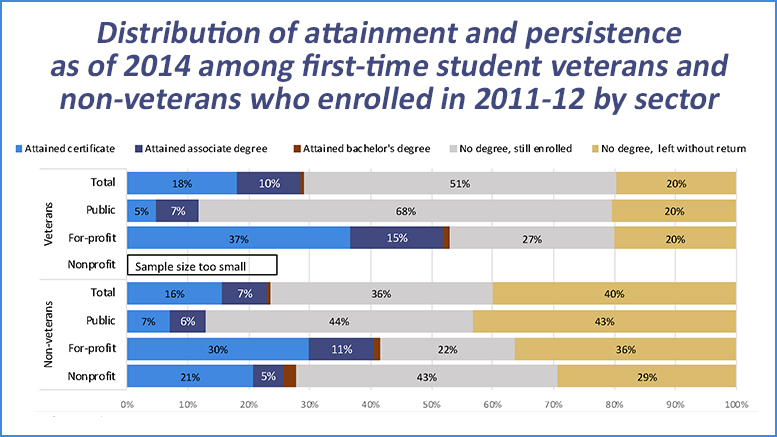Military veterans in postsecondary education are more likely to earn an associate degree or certificate than their non-veteran peers. But veterans tend to take longer to complete.
That’s one of the key findings from a new report by Veterans Education Success.
An analysis of data from the U.S. Department of Education’s longitudinal Beginning Postsecondary Students (BPS) study, which surveyed first-time students twice between 2011 and 2014, found 28 percent of veterans had earned a certificate or associate degree compared to 23 percent of non-veterans.
Just 20 percent of veterans who first enrolled in any type of postsecondary education in 2011-12 had left without a degree by 2014, compared to 40 percent of non-veterans, according to the report.
Half of the veterans surveyed were still enrolled three years after starting school, while only about one-third of non-veterans were still pursuing a degree.
The BPS data likely overstate veterans’ non-completion rates because so many of them stop out and then return to finish their degrees, “so we consider the 2014 results fluid,” says Walter Ochinko, research director at Veterans Education Success and co-author of the report.
Forty percent of veterans who completed certificates or degrees in 2015-16 began their postsecondary education in 2015 or earlier, compared to about 30 percent of non-veterans.
Resilience despite risk factors
According to Veterans Education Success, “student veterans, despite numerous risk factors and challenges, demonstrate stronger rates of persistence and completion of higher education goals than non-veterans.”
Veterans who left without a degree in 2014 are more likely to experience risk factors often linked with non-completion. For example, veterans were more likely to be the first in their family to go to college, lack a traditional high school diploma, be disabled, have dependents and work full time.
Among veterans, 21 percent were more likely to have five or more risk factors associated with non-completion compared to 4 percent of non-veterans.
While non-graduates are more likely than graduates to have a hard time repaying student loans, the report found even small amounts of debt can cause financial stress among both graduates and non-graduates. Despite monthly payments of $100 or less for 65 percent of veterans, about three-quarters of them have had a forbearance and almost all have had at least one delinquency.
Those who attended community colleges were less burdened by debt, however. Seventy-two percent of veterans who left college had no student loan debt, which the report attributes to the more generous post-9/11 GI Bill and because a considerable proportion of veterans attend inexpensive community colleges.
More supports needed
The report offers several recommendations to help veterans meet their higher education goals:
- Campus-based daycare would benefit veterans who are single parents.
- Targeted institutional grants and work-study programs would help veterans supplement their GI Bill benefits or reduce their need for employment.
- The high level of disabilities among veterans suggests the need to improve accessibility of the Veterans Administration and campus-based health services for them.
- Programs fostering persistence and attainment should be broad in scope and should address the full range of risk factors.
- Efforts to ensure veterans are prepared for rigorous degree programs should begin while they are still in the military.
As an example, the U.S. Defense Department’s Transition Assistance Program, which allows service members to take classes that help them earn a promotion to a higher rank, could be re-imagined as a pipeline to prepare high school graduates to focus on post-service career goals and classes that will help them avoid using their GI Bill benefits on remedial courses.


